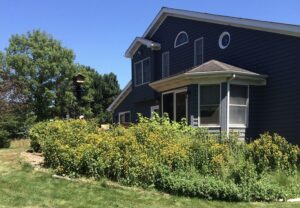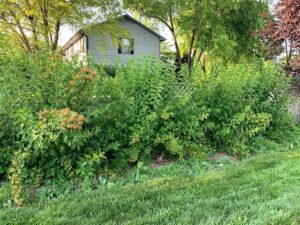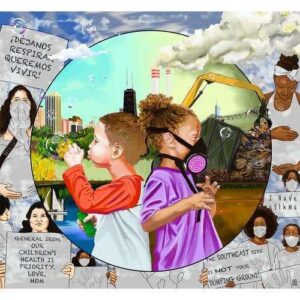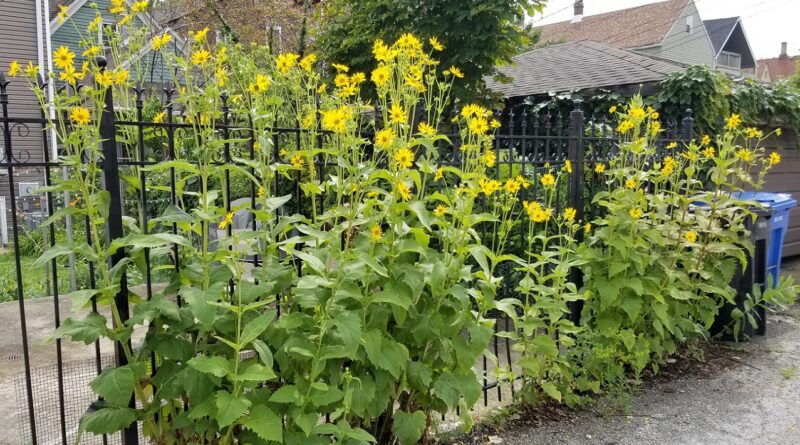When Native Garden Plans Go Bad (and Good)
Podcast: Play in new window | Download (Duration: 1:55:24 — 54.9MB)
Subscribe: Apple Podcasts | Spotify | Android | iHeartRadio | Podchaser | Email | TuneIn | RSS | More
(January 24, 2021) Peggy and I have spent (at least it seems to me) a lot of time lately talking about new gardeners. We have reported on the millions of gardeners created last year in the midst of the COVID-19 crisis. Two weeks ago, we interviewed two of those new gardeners. Because of issues with food security, their focus is often on growing vegetables. However, the pandemic also made folks aware of our worldwide climate crisis. And that has led them to turn to native plants in their gardens. On today’s show, we examine what happens when native garden plans go bad…and good.
That headline is written a little tongue-in-cheek, because we get to talk to friend of the show Ken Williams.
Ken Williams has worked in horticulture for almost 30 years. As a young man he first fell in love with native flora while hiking alpine meadows in Colorado. Later he found a similar sublime beauty in the tall grass prairies of southeast Kansas. He combined this interest with a lifetime of vegetable gardening experience to develop native plant gardening techniques. For 16 years, he applied these techniques to the landscape of a 100 acre city park and zoo. Since 2008, often collaborating with his wife Christine Nye, he has participated in the Chicago area ecological landscape movement.
Indeed, it was through Christine Nye, former Horticulture Manager at the Shedd Aquarium that I met Williams. Nye was one of the early members of the Midwest Ecological Landscape Alliance (MELA), which I co-founded in 2002, but which was folded into the Illinois Landscape Contractors Association (ILCA) in 2017.

Then, last week, I saw that Ken will be doing a presentation for the West Cook Wild Ones. It’s called Top Ten Things Every Native Gardener Needs To Know. It’s part of a trio of presentations about gardening with native plants that WCWO is presenting, starting with Ken’s talk on Sunday, February 21. He says he was contacted by Laura Hartwell Berlin and Adrian Ayers Fischer from West Cook Wild Ones.
They indicated that last year as the pandemic sunk in and interest in native gardening increased, they had a lot of neophytes participate in their native plant sale. Many of these people craved information. Their response to this was to arrange a three part series of webinars for beginners, starting with mine in February. The next one will be Denise Sandoval in March and then a panel discussion with Monica Buckley and Sarah Michehl in April.
Ken says his goal is to answer questions that the Wild Ones folks get from first time participants at their plant sale. For example, why should you plant plugs instead of more mature plants in gallon containers. He plans to include information on site preperation, design, installation, maintenance, why leaving leaves in the fall is a good idea, and more.
Denise Sanoval is with Good-Natured Landscapes, which serves Chicago’s far western suburbs. Her presentation is Gardening with Native Plants Through the Seasons. on March 21.

Monica Buckley has been on our show, and runs Red Stem Native Native Lanscapes, Inc. Sarah Michehl is Community Engagement Specialist for The Land Conservancy of McHenry County. Together, they will present Native Plant Garden Q&A on April 18.
Today we welcome Ken Williams and Sarah Michehl to give previews of their respective talks. They also claim they have made a lot of mistakes while learning about native plants, which is why I’ve included a couple of photos they sent. Many of you will undoubtedly wonder what the “mistakes” are, given how lush their gardens appear to be.
That’s why the photo of my Logan Square Chicago neighborhood is at the top. Those are cup plants (Silphium perfoliatum). They started in my yard and now have spread into the alley, where they grow out of cracks in the asphalt. FYI, that’s NOT my backyard behind that wrought iron fence. This is a case of when native garden plans go bad. A word to the wise: if you grow cup plants, keep an eye on them.
Environmental Injustice on Chicago’s southeast side
There’s a battle for the soul–and the health–of Chicago’s southeast side, which has been going on for decades. You could legitimately say that the struggle has stretched more than a hundred years, back to when places like the 10th Ward were economic powerhouses, thanks to the steel industry. The legacy of that industry is also a legacy of industrial pollution.

The 10th ward has always been the industrial hub for the Midwest. The steel mills, specifically, were the industries that breathed economic life into the community. Thousands were employed at livable wages, and although the environmental repercussions were nowhere near the consideration of citizens or government entities, the quality of life in these neighborhoods was good. When steel manufacturing left for overseas in the early 2000s, what came to replace it was an array of companies that not only hired far fewer locals, but also released extremely harmful pollutants such as petroleum byproduct (petcoke), lead and manganese. These minority communities like South Deering, East Side and Hegewisch not only became impoverished but also became sick from the chemicals in the air and soil.
In August of last year, Peggy Malecki and I did a segment about two environmental issues in the 10th Ward. As I wrote at the time,
Whether the issue is petcoke storage or dirty industries or expanding a toxic dump at the mouth of the Calumet River on the shores of Lake Michigan or general vulnerability to environmental toxins, the southeast side of Chicago is almost always near or at the top of the list of places you wouldn’t want to live if you had a choice.
That sentiment was echoed on the show by Gina Ramirez from the Natural Resources Defense Council (NRDC) and Peggy Salazar, executive director of the Southeast Environmental Task Force (SETF).
Like I said, nobody knows we exist. Why? It’s the community nobody wants to move to. Nobody wants to live here, unless you’ve been here already. And then you tend to stay here and fight to make it better.
One of the things SETF is fighting is the relocation of a company called General Iron Industries to 11600 S. Burley Ave. on the southeast side. The iron scrapper is owned by Reserve Management Group, and recently shut its operations in Lincoln Park on Chicago’s north side. To say that the company has had a checkered relationship with its old neighborhood would be an understatement. In 2019, the RMG signed an agreement with the City to close its north side operations by the end of 2020.
Following the settlement, Lincoln Park neighbor Lara Compton told Block Club she feared for the health and safety of East Side neighbors.
“We have been filing complaints literally for years,” she said. “For an administration that ran on transparency, the lack of transparency for the North Siders’ fight to be able to breath fresh air, and the South Siders’ fight to stop the company from moving there … it has been anything but transparent.”
Other problems with General Iron include a 2015 fire, a 2016 city-ordered shutdown, a 2017 harassment lawsuit and a 2018 citation for excessive air emissions.
The proposed location in the 10th Ward is just down the street from George Washington elementary and high schools. SETF, Chicago South East Side Coalition to Ban Petcoke, and other organizations are fighting that move.
The operation under construction has been highly contentious as community members and environmental groups have fought to keep the business from starting up. The new facility, to be rebranded Southside Recycling, is the subject of both a federal lawsuit and a complaint to federal housing officials. Both complaints, naming Mayor Lori Lightfoot and the city, allege the relocation of a polluting nuisance from mostly white Lincoln Park to a Latino-majority community is a violation of residents’ civil rights.
Lightfoot’s Administration has denied allegations in the federal complaints and has said it will conduct a thorough review of the permit application, though residents say they don’t want the business at all.
On our show in August, Salazar listed one more reason for keeping the company out of the neighborhood.
So what that means for us, of course, is the amount of pollution; the fact also that the truck traffic will be horrendous. We did an informal truck count, and we, at this point in time found two hundred trucks going through an intersection in an hour. At any intersection, in our neighborhood, two hundred trucks plus. This is now. We still don’t have the warehouses that they’re building completed, we still don’t have General Iron moving down here. So, we can’t even envision what the truck traffic is going to be like. And those were all of our concerns we voiced. That when you concentrate industry in one area, these are the other impacts to the community that nobody cares about or gives consideration to.
Public comments on that permit application were originally to have been submitted by January 14. However, on that day, the Mayor’s Office of Community Engagement sent out this letter.
You recently registered to participate in a Public Hearing convened by the Chicago Department of Public Health (CDPH) related to the metal recycling facility permit application of RMG, located at 11600 S. Burley. After review of the application and consideration of community views, CDPH required RMG to submit an amended application. That amended application was posted today and can be found here: Large Recycling Facility Permit Application. To allow for community input on this revised application, CDPH has extended the written public comment period to an additional fifteen (15) days. The deadline for additional public comments is 11:59 pm on Friday, January 29, 2021.
If you want to read all of that application, it’s more than 1,100 pages long. Good luck. That said, comments are being accepted at envcomments@cityofchicago.org.
Peggy Salazar visits with us again on today’s show. She is joined by Nancy C. Loeb, Clinical Professor of Law and Director of the Environmental Advocacy Clinic for the Bluhm Legal Clinic at the Northwestern Pritzker School of Law.
And if wrapping your head around this one issue isn’t difficult enough, consider the project that is being proposed by Ozinga Bros. Inc. They want to create a 6 million square foot warehouse–underground.
The proposed space, to be built over 13 years, would be 250 to 350 feet underground and is being initially touted as a home for storage, data centers, light manufacturing or a number of other potential uses.
Project officials say the land is likely so toxic it could cost hundreds of millions of dollars to clean up, but they believe by locating the facility well below the surface they can avoid that and still operate safely.
Not surprisingly, Salazar, in the article and on the phone to me, says she has reservations. She wants to know why every time there’s a heavy industrial proposal made for Chicago, the location ends up being in the 10th Ward. We’d all like to know the answer to that question.
Speaking of the Calumet River, here’s a piece by Olga Bautista, community planning manager at the Alliance for the Great Lakes Bauktista, who helped form the Southeast Side Coalition to Ban Petcoke, argues for more transparency in environmental decision-making.
Note: there’s a paywall to Crain’s Chicago Business. I hope they let you read this one article for free.


